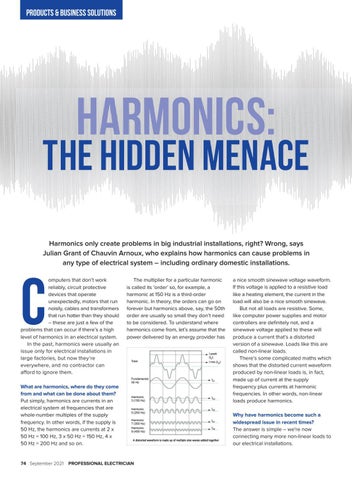074_PE_SEPT21_Layout 1 05/08/2021 19:12 Page 74
PRODUCTS & BUSINESS SOLUTIONS
HARMONICS:
THE HIDDEN MENACE Harmonics only create problems in big industrial installations, right? Wrong, says Julian Grant of Chauvin Arnoux, who explains how harmonics can cause problems in any type of electrical system – including ordinary domestic installations.
C
omputers that don’t work reliably, circuit protective devices that operate unexpectedly, motors that run noisily, cables and transformers that run hotter than they should – these are just a few of the problems that can occur if there’s a high level of harmonics in an electrical system. In the past, harmonics were usually an issue only for electrical installations in large factories, but now they’re everywhere, and no contractor can afford to ignore them.
The multiplier for a particular harmonic is called its ‘order’ so, for example, a harmonic at 150 Hz is a third-order harmonic. In theory, the orders can go on forever but harmonics above, say, the 50th order are usually so small they don’t need to be considered. To understand where harmonics come from, let’s assume that the power delivered by an energy provider has
What are harmonics, where do they come from and what can be done about them? Put simply, harmonics are currents in an electrical system at frequencies that are whole-number multiples of the supply frequency. In other words, if the supply is 50 Hz, the harmonics are currents at 2 x 50 Hz = 100 Hz, 3 x 50 Hz = 150 Hz, 4 x 50 Hz = 200 Hz and so on.
74 September 2021
PROFESSIONAL ELECTRICIAN
a nice smooth sinewave voltage waveform. If this voltage is applied to a resistive load like a heating element, the current in the load will also be a nice smooth sinewave. But not all loads are resistive. Some, like computer power supplies and motor controllers are definitely not, and a sinewave voltage applied to these will produce a current that’s a distorted version of a sinewave. Loads like this are called non-linear loads. There’s some complicated maths which shows that the distorted current waveform produced by non-linear loads is, in fact, made up of current at the supply frequency plus currents at harmonic frequencies. In other words, non-linear loads produce harmonics. Why have harmonics become such a widespread issue in recent times? The answer is simple – we're now connecting many more non-linear loads to our electrical installations.
